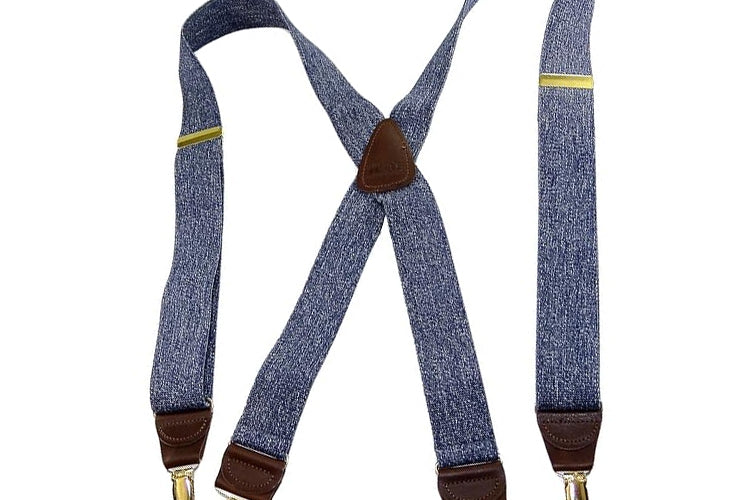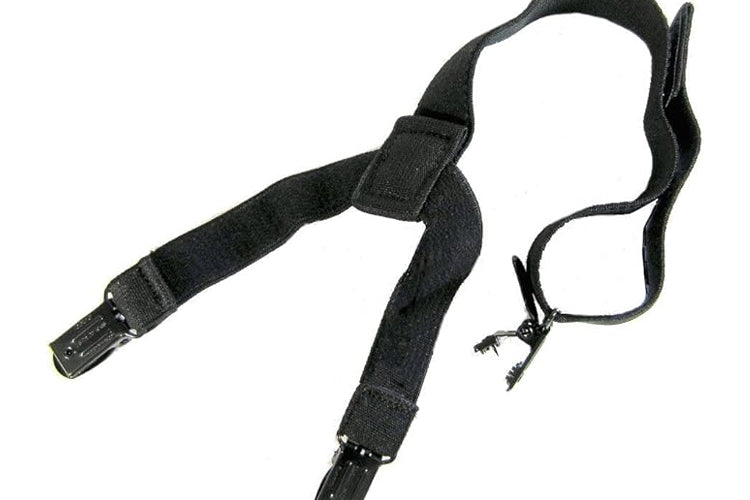Comfort and functionality are key concerns for law enforcement officers, military personnel, and anyone who must wear a duty belt for extended periods. The distribution of essential gear weight can significantly affect overall performance, reducing strain on the body and improving endurance. Among the most common options for weight distribution are the duty belt and suspenders. But how do they compare when it comes to evenly distributing the weight of a heavy load? Let's take a closer look at each option.
Get your heavy-duty, chestnut-brown work suspenders now and carry with confidence.
Which is better for weight distribution, a duty belt or suspenders?
Both duty belts and suspenders are designed for support during the execution of an officer's or a soldier's day-to-day tasks. A duty belt is commonly worn around the waist, whereas suspenders distribute the weight across the shoulders. However, the choice depends on various factors, including weight, mobility requirements, and the wearer's preferences.
Generally, duty belts can concentrate the load at the waist, further leading to low back strain and discomfort if loads are not well balanced. Suspenders, therefore, have an advantage in evenly spreading the load, potentially decreasing lower back strain as the load shifts to the shoulder area.
Weight Distribution of Duty Belt vs. Suspenders
Weight distribution in both duty belts and suspenders greatly affects how well gear is carried throughout the day. Let us break down each method to understand its pros and cons.
Duty Belt: Centralized Weight around the Waist
A duty belt is designed to carry vital equipment, such as handcuffs, radios, flashlights, firearms, and extra magazines, among other tools. The belt sits around the hips, securing all gear at the waist.
Pros of Duty Belts
-
Quick Access: The belts allow access to important duty tools during stressful situations.
-
Security: They keep everything in place so the gear does not shift, preventing damage to the gears.
Cons of Duty Belts
-
Weight Concentration: The main drawback is that all the weight is concentrated around the waist. This produces discomfort and strain on the lower back.
-
Long-term Strain: Extended wear can promote muscle fatigue and poor posture, and may even lead to chronic back pain.
-
Limited Comfort: While newer duty belts feature padding and ergonomic features, the weight is highly concentrated and can be significant with heavy gear.
Suspenders
Suspenders distribute weight evenly across both shoulders. It serves as a solution by shifting the weight from the waist to the shoulders, giving a more effective load distribution.
Pros of Suspenders
-
Balanced load: Suspenders evenly distribute the weight across the shoulders, lifting it off the lumbar spine.
-
Reduced Strain: This balance helps maintain a more natural posture and reduces the risk of musculoskeletal strain.
-
Improved Mobility: When carrying heavier loads for extended periods, suspenders enhance overall comfort and mobility.
Cons of Suspenders
-
Discomfort if Improperly Fitted: If not adjusted properly, suspenders can cause discomfort around the shoulders and neck, making them less ideal for some users.
Combining Both: Hybrid Solutions
Some users prefer a hybrid approach that combines both the duty belt and suspenders. In such systems, suspenders are integrated with a duty belt to offer the best of both worlds. The suspenders help to support the weight, while the belt secures the gear around the waist for stability and easy access.
These hybrid systems are extremely useful for military personnel and law enforcement officers who need to carry extensive gear with minimal discomfort. The suspenders help alleviate the weight on the waist, while the duty belt keeps everything secure and easily accessible.
Conclusion
Ultimately, the decision between a duty belt and suspenders comes down to personal preference, the type of gear one will be carrying, and their comfort threshold for the task at hand. While duty belts are more traditional and allow quick access to tools, suspenders offer a balanced approach to weight management, reducing strain on the lower back for increased comfort.
For those who need to move with heavier loads or stay on their feet longer, suspenders are the better choice. Still, most hybrid systems offer the best of both worlds, providing support, stability, and comfort.
Frequently Asked Questions
Can suspenders replace a duty belt completely?
Suspenders can distribute the weight, but they are usually used in addition to a duty belt rather than replacing it entirely. The best support comes from a combination of both.
Are suspenders uncomfortable to wear?
Suspenders are not comfortable if they do not fit or are not adjusted correctly. Still, if worn correctly, they should be highly comfortable, redistributing weight from the waist to the shoulders.
Can a duty belt cause long-term back problems?
Yes, if the weight is not spread out appropriately, a duty belt can contribute to lower back strain over time. To help prevent this, select a belt with proper padding and ergonomic features, or consider using suspenders for better weight distribution.
How can I make my duty belt more comfortable?
A padded belt can make things more comfortable. It helps distribute the weight evenly and can be adjusted to fit snugly without being too tight. For heavy loads, using suspenders can reduce pressure on your lower back.






